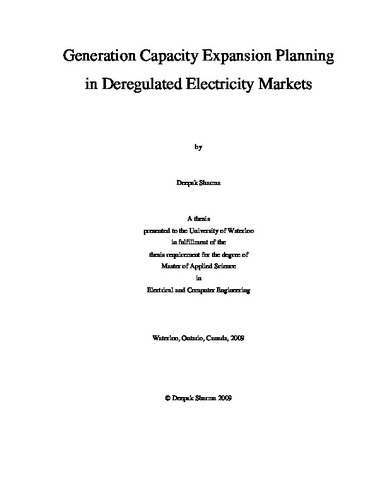| dc.contributor.author | Sharma, Deepak | |
| dc.date.accessioned | 2009-05-22 16:21:11 (GMT) | |
| dc.date.available | 2009-05-22 16:21:11 (GMT) | |
| dc.date.issued | 2009-05-22T16:21:11Z | |
| dc.date.submitted | 2009-05-20 | |
| dc.identifier.uri | http://hdl.handle.net/10012/4449 | |
| dc.description.abstract | With increasing demand of electric power in the context of deregulated electricity markets, a good strategic planning for the growth of the power system is critical for our tomorrow. There is a need to build new resources in the form of generation plants and transmission lines while considering the effects of these new resources on power system operations, market economics and the long-term dynamics of the economy. In deregulation, the exercise of generation planning has undergone a paradigm shift. The first stage of generation planning is now undertaken by the individual investors. These investors see investments in generation capacity as an increasing business opportunity because of the increasing market prices. Therefore, the main objective of such a planning exercise, carried out by individual investors, is typically that of long-term profit maximization.
This thesis presents some modeling frameworks for generation capacity expansion planning applicable to independent investor firms in the context of power industry deregulation. These modeling frameworks include various technical and financing issues within the process of power system planning. The proposed modeling frameworks consider the long-term decision making process of investor firms, the discrete nature of generation capacity addition and incorporates transmission network modeling. Studies have been carried out to examine the impact of the optimal investment plans on transmission network loadings in the long-run by integrating the generation capacity expansion planning framework within a modified IEEE 30-bus transmission system network.
The work assesses the importance of arriving at an optimal IRR at which the firm’s profit maximization objective attains an extremum value. The mathematical model is further improved to incorporate binary variables while considering discrete unit sizes, and subsequently to include the detailed transmission network representation. The proposed models are novel in the sense that the planning horizon is split into plan sub-periods so as to minimize the overall risks associated with long-term plan models, particularly in the context of deregulation. | en |
| dc.language.iso | en | en |
| dc.publisher | University of Waterloo | en |
| dc.subject | Investment planning | en |
| dc.subject | deregulation | en |
| dc.subject | profit maximization | en |
| dc.subject | internal rate of return | en |
| dc.title | Generation Capacity Expansion Planning in Deregulated Electricity Markets | en |
| dc.type | Master Thesis | en |
| dc.pending | false | en |
| dc.subject.program | Electrical and Computer Engineering | en |
| uws-etd.degree.department | Electrical and Computer Engineering | en |
| uws-etd.degree | Master of Applied Science | en |
| uws.typeOfResource | Text | en |
| uws.peerReviewStatus | Unreviewed | en |
| uws.scholarLevel | Graduate | en |

